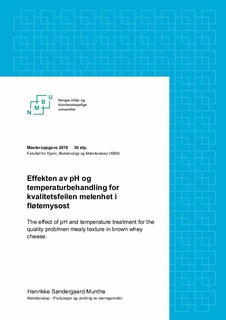| dc.contributor.advisor | Johansen, Anne-Grethe | |
| dc.contributor.author | Munthe, Henrikke Søndergaard | |
| dc.coverage.spatial | Norway | nb_NO |
| dc.date.accessioned | 2019-11-05T11:37:12Z | |
| dc.date.available | 2019-11-05T11:37:12Z | |
| dc.date.issued | 2019 | |
| dc.identifier.uri | http://hdl.handle.net/11250/2626588 | |
| dc.description.abstract | Brunost er et tradisjonsrikt produkt i Norge og har vært industrielt produsert siden starten av 1860-tallet. Osten er sammensatt av myse, som blandes med melk og fløte, enten fra ku, geit eller begge deler. Disse næringsmiddelene kokes sammen, og skal gi en ost med fast konsistens, men som også myk og skjærbar med ostehøvel. Osten har høyt tørrstoffinnhold på ca. 80%, som består av proteiner, fett og laktose. Under produksjon av brunost forekommer det kvalitetsfeil som gir sandet eller melen ost. Det har lenge vært konkludert at disse kvalitetsfeilene skylles utilstrekkelig røring og kjøling under pakking, som gir store laktosekrystaller og forårsaker sandet eller melen konsistens. Men produksjon av brunost er også sterkt avhengig av operatørenes kunnskap og erfaring, og en teori har vært at melen konsistens i brunost kan skylles forhold som skjer under selve innkokingen av ostemassen.
Hensikten med oppgaven var derfor å se om kvalitetsfeilen melen kunne påvirkes av andre faktorer enn pakking. I forsøket ble det produsert brunost der faktorene koketemperatur under produksjon og pH-justering av brunostkonsentratet variert.Det ble foretatt pH-målinger, tørrstoffpørver, måling av proteinprosent og fettanalyser. Teksturprøver av osten ble analysert og det ble målt flyktige komponenter i ost og brunostkonsentrat. Det ble også utført en kvalitetsbedømmelse og en beskrivende sensorisk analyse.
Resultatene viste at det fantes signifikant forskjell som påvirkning av pH-justering for melen konsistens i brunostene produsert i forsøket. Analysen av de flyktige viste at temperaturbehandlingen hadde signifikant effekt for dannelsen av de viktigste smakskomponentene i brunost; 2-Furamentanol og 2-Hetanon, der høy temperaturbehandling dannet høyere konsentrasjon av de flyktige komponentene, enn lav temperaturbehandling. Det ble også funnet at både temperaturbehandling og pH-justering hadde signifikant effekt for teksturen i brunost, der høy temperaturbehandling og pH-justering ga fastere tekstur i osten enn lav temperaturbehandling og ikke-justert pH. | nb_NO |
| dc.description.abstract | Brown whey cheese is product with a long-established tradition in Norway and has been produced industrially since the beginning of the 1860s. The brown whey cheese consists of whey, mixed with milk and cream form either bovine, goat or a combination of both. The ingredients are cooked and are to produce a cheese with firm consistency, while still being soft and sliceable with a cheese slicer. The cheese has ha high dry matter content of about 80% consisting of proteins, lipids and lactose. During production there sometimes arise quality problems which gives the cheese a sandy or mealy texture. The conclusion for these problems has for a long time been explained as a cause of insufficient stirring and cooling during packaging, causing formation of big lactose crystals and then mealy or sandy texture in the cheese. The quality of brown whey cheese during production is also strongly dependent on the knowledge and experience of the operator, and thus a theory has formed, stating that the mealy texture in brown whey cheese can be caused by conditions during the cooking process. The aim for the thesis was to look into if the mealy texture found in brown whey cheese, could be caused by other factors than the packaging conditions. During the thesis brown whey cheese was produce and the cooking temperature varied and pH in the concentrate was adjusted.
There were carried out dry matter content analysis, pH and protein concentration and fat concentration were measured. Texture analysis were carried out and volatile compounds in the cheese and concentrate were analysed. A quality assessment and a descriptive sensory analysis were performed.
The results concluded that a significant difference as influence of the pH adjusting could be found for the mealy texture in the brown whey cheeses produced in the project. The analysis for the volatile compounds showed significant effect for the formation of the most important flavour compounds in brown whey cheese; 2-Furamethanol and 2-Heptanone, where high temperature treatment caused higher concentration of these compounds than low temperature treatment. There was also found that both temperature treatment and pH-adjusting caused a firmer consistency in the cheese, where the high temperature treatment and pH-adjusted concentrates produced a firmer cheese, than the cheese with low temperature treatment and non-adjusted pH. | nb_NO |
| dc.description.sponsorship | TINE SA | nb_NO |
| dc.language.iso | nob | nb_NO |
| dc.publisher | Norwegian University of Life Sciences, Ås | nb_NO |
| dc.rights | Attribution-NonCommercial-NoDerivatives 4.0 Internasjonal | * |
| dc.rights.uri | http://creativecommons.org/licenses/by-nc-nd/4.0/deed.no | * |
| dc.subject | Ost | nb_NO |
| dc.title | Effekten av pH og temperaturbehandling for kvalitetsfeilen melenhet i fløtemysost | nb_NO |
| dc.title.alternative | The effect of pH and temperature treatment for the quality problem mealy texture in brown whey cheese | nb_NO |
| dc.type | Master thesis | nb_NO |
| dc.subject.nsi | VDP::Matematikk og Naturvitenskap: 400 | nb_NO |
| dc.source.pagenumber | 60 | nb_NO |
| dc.description.localcode | M-MAT | nb_NO |

